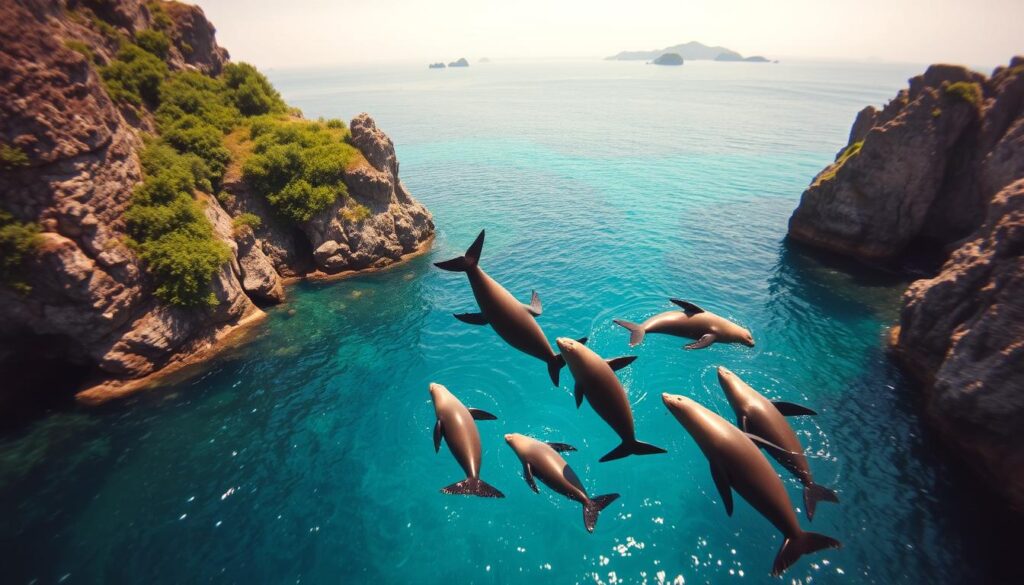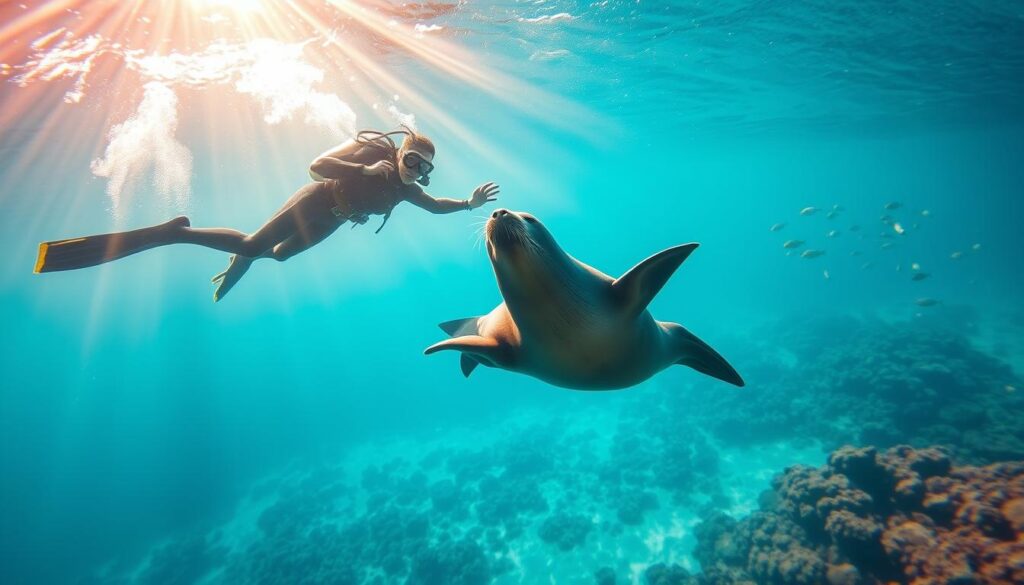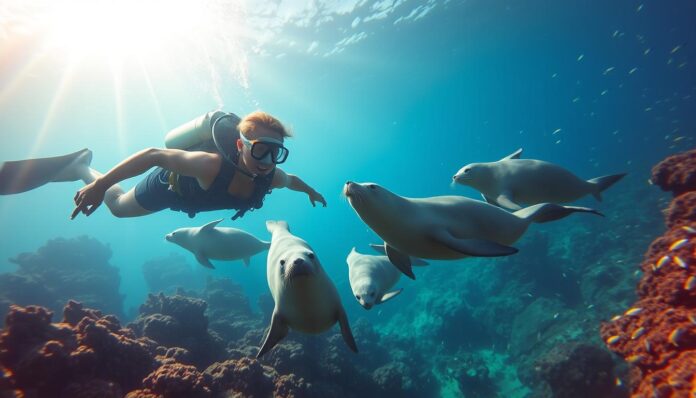Did you know that diving with seals can make a diver 80% happier? Scuba diving with seals is an amazing experience that turns a regular dive into an adventure. These playful marine mammals make magical moments underwater, inviting divers into their secret world.
Seal encounters are more than just swimming with marine life. They offer a chance to see how smart these creatures are in their own home. Whether you’re new or experienced, diving with seals gives you memories you’ll never forget and a connection to the sea.
From the cold waters of the Farne Islands to the colorful reefs of Bali, there are many places to dive with seals. Professional dive guides teach you how to dive safely and respectfully with these amazing animals.
Key Takeaways – Diving with Seals
- Seal diving increases diver satisfaction by up to 80%
- Proper training is key for safe seal encounters
- Many places around the world offer unique seal diving experiences
- Seeing underwater wildlife helps us care more about the sea
- Seal behavior changes with the seasons and where they live
Introduction to Scuba Diving with Seals
Exploring marine life with seals is an amazing underwater adventure. It turns regular diving into a special encounter. Seal swimming tours let you meet these playful marine mammals in their home.
Before diving with seals, you need to get ready and know about marine environments. There are important things to think about before starting this amazing journey.
What You Need to Know Before You Dive
- Minimum diving certification: Open Water level
- Age requirement: 12 years and older
- Recommended physical fitness: Moderate swimming ability
- Water temperature range: 16°C – 24°C
To dive with seals well, you need the right training and to know how to interact with marine wildlife. Divers must respect the natural environment and keep a safe distance from marine creatures.
The Benefits of Diving with Wildlife
| Benefit Category | Description |
|---|---|
| Educational | Learn about seal behavior and marine ecosystems |
| Personal Growth | Develop appreciation for marine conservation |
| Environmental Awareness | Understand marine wildlife protection |
“Diving with seals is not just an adventure, it’s a profound connection with nature’s most fascinating creatures.”
Experiences like seal swimming tours are more than fun activities. They are a journey into understanding marine ecosystems and wildlife conservation.
Best Locations for Seal Diving
Seal watching dives offer marine mammal adventures that promise unforgettable underwater experiences. Divers seeking incredible wildlife encounters have numerous spectacular destinations to explore around the world.
Popular Destinations in the United States
The United States boasts remarkable seal diving locations that attract marine enthusiasts from everywhere. Key destinations include:
- Monterey, California: Home to playful sea lions swimming at speeds up to 20 mph
- Channel Islands: Featuring diverse marine ecosystems and abundant seal populations
- Isle of Shoals: Where over 100 seals populate summer waters, increasing to 800 during winter months
International Hotspots for Seal Encounters
Global marine mammal adventures extend far beyond US borders, providing extraordinary seal watching dives in breathtaking locations:
- United Kingdom: The Farne Islands host thousands of grey seals, creating an incredible diving experience
- Galapagos Islands: Features both fur seals and sea lions at nearly every dive site
- New Zealand: Kaikoura provides remarkable opportunities to encounter intelligent fur seals
“The ocean is a magical world where seals transform from curious observers to playful companions.” – Marine Wildlife Expert
When planning marine mammal adventures, consider seasonal variations and local guidelines. This ensures responsible and safe seal diving experiences.
The Amazing World of Seals
Diving into the underwater world reveals a mesmerizing realm of marine mammals. Seals are among the most charming creatures in our oceans. They offer unforgettable opportunities for up-close interactions.
Seals are remarkable marine mammals with unique traits and behaviors. Their survival skills allow them to thrive in harsh marine environments.
Types of Seals You May Encounter
Divers can meet several fascinating seal species underwater:
- California Sea Lions – Weighing up to 400 pounds
- Gray Seals – Growing populations along the U.S. East Coast
- Hawaiian Monk Seals – Most endangered pinniped in U.S. waters
- Australian Fur Seals – Known for thick protective fur layers
Seal Behavior and Habitat
Knowing seal behavior is key for safe underwater interactions. Marine experts advise keeping a respectful distance and avoiding direct eye contact to prevent perceived threats.
“Seals are curious creatures that can provide incredible underwater experiences when approached with knowledge and respect.” – Marine Mammal Research Institute
Different seal species live in various marine environments. Their social structures and feeding habits vary, making each encounter unique.
Pro tip for divers: Shallow dives and snorkeling near the surface increase chances of engaging seal interactions. These marine mammals often swim close to the surface.
Essential Gear for Seal Diving
Getting ready for scuba diving with seals means picking the right gear. The right equipment makes your underwater adventures unforgettable. Each piece is key for comfort, safety, and enjoying marine life.
Choosing the Right Thermal Protection
Thermal protection is key when diving with seals. You have two main choices:
- Wetsuits: Good for moderate temperatures
- Dry suits: Best for cold water
Advanced Diving Systems for Seal Interactions
The Avelo dive system is a game-changer. This tech lets divers move freely and easily connect with marine life while diving with seals.
Essential Equipment Checklist
For a great seal diving experience, you need:
- 12L or 80 cu ft scuba tank
- Dive computer with many features
- Weight system with pockets
- High-quality mask for clear vision
- Fins for easy movement underwater
“The right equipment turns a simple dive into an amazing underwater adventure.” – Marine Exploration Experts
Recommended Cutting and Lighting Tools
For safety and to document your dives, consider these tools:
- Dive Rite Ceramic Line Cutter
- Dive Rite CX2 Dive Light
- Kraken Hydra 15000 WRGBU Video Light
Choosing the right gear makes seal diving safe, comfy, and memorable. It lets you connect deeply with these amazing sea creatures.
Training and Certification
Scuba diving with seals needs special training and a professional certification. It’s not just about basic diving skills. You must learn unique skills to safely meet marine mammals.
Importance of Proper Training
Getting the right training is key for safe marine encounters. It teaches you important skills like:
- Wildlife interaction protocols
- Advanced buoyancy control
- Safety techniques for marine environments
- Understanding seal behavior
Recommended Certifications for Seal Diving
For diving with seals, consider these certifications:
- PADI Marine Mammal Awareness Course
- Advanced Open Water Certification
- PADI Seal Team Program
“Knowledge and preparation are your best companions in marine wildlife experiences.”
The PADI Seal Team program is great for young divers. It includes:
- Minimum age: 8 years old
- 5 Specialty AquaMissions to become a member
- Each mission lasts approximately 1 hour
- Cost starts at $50.00
Investing in proper training guarantees a safe, educational, and unforgettable seal diving adventure.
Planning Your Seal Diving Trip
Going on marine mammal adventures needs careful planning and the right timing. Seal encounters require thoughtful preparation. This ensures a safe and memorable underwater experience.
Best Seasons for Seal Diving
Choosing the best time for your dive can greatly improve your seal encounters. Different places have their own best times:
- Hawaii: Best for monk seal sightings from May to October
- Farne Islands: Peak grey seal encounters in September
- New Zealand: Hooker Sea Lion tours from October to May
- Antarctica: Southern summer months (November to March)

Choosing the Right Diving Operator
Finding a reputable diving operator is key for safe and responsible seal encounters. Look for these important factors:
- Verify guide certifications and wildlife expertise
- Check safety records and equipment quality
- Review adherence to wildlife protection guidelines
- Evaluate group size and experience level
“The magic of marine mammal adventures lies not just in the encounter, but in responsible interaction.”
Do your research on local regulations and the operator’s specializations. This ensures a memorable and ethical diving experience. Good preparation turns a simple dive into an amazing marine adventure.
Safety Tips for Diving with Seals
Scuba diving with seals needs careful planning and awareness. It’s important to respect and know the underwater world. This ensures a safe and memorable dive.
Critical Safety Precautions
Divers must know the risks of seal interactions. There are several key safety tips:
- Maintain a minimum 100-meter distance from seals on rocks
- Limit encounter duration to less than 15 minutes
- Wear a protective wetsuit to prevent injuries
- Use calm, non-threatening body movements
Understanding Seal Behavior Risks
Seal encounters can be dangerous if you cross certain lines. Aggressive behaviors typically emerge when humans:
- Block a seal’s escape route to the ocean
- Interfere between a mother and her pup
- Interrupt males during territorial challenges
“Preparation and respect are the foundations of safe seal diving experiences.”
Emergency Response Strategies
About 90% of diving emergencies can be solved with good communication and buddy help. Important emergency steps include:
- Establish clear communication signals
- Always dive with a trained buddy
- Carry emergency oxygen equipment
- Know basic underwater first aid techniques
By sticking to these safety tips, divers can have amazing seal diving experiences. They also protect themselves and the underwater world.
Respecting Wildlife and Environment
Going on marine life experiences means we must care for the environment and respect underwater life. Tours that include seal encounters need more than just fun. They require deep respect for marine animals.
Diving with seals is both exciting and a chance to help protect them. It’s important to know how to balance being with wildlife and protecting it.
Guidelines for Responsible Diving
Responsible seal diving means following some key rules:
- Maintain a minimum distance of 15 feet from seals
- Avoid sudden movements or loud noises
- Never attempt to touch or feed marine animals
- Follow strict marine mammal protection regulations
- Use minimal lighting and quiet underwater equipment
The Impact of Human Activity on Seals
Human actions can harm seal populations. The Marine Mammals Protection Act is key to protecting them. Research shows that too many dives can stress seals, changing their behavior.
“Respect the ocean, and it will reveal its magnificent secrets.” – Marine Conservation Expert
Important environmental effects include:
- Potential habitat disruption
- Increased stress levels in seal populations
- Risk of altering natural migration patterns
- Potential transmission of human-originated diseases
By diving responsibly, we can make a difference. We can help protect these amazing creatures for the future.
Unique Experiences: Dive with Seals
Seal swimming tours offer an extraordinary underwater adventure. They connect divers with the ocean’s most playful marine mammals. Up-close seal interactions create memories that last a lifetime, turning an ordinary dive into an extraordinary encounter with wildlife.

Remarkable seal diving destinations around the world promise unforgettable experiences:
- Baja California, Mexico: Swim with over 200 California sea lions at Los Islotes
- Kaikoura, New Zealand: Explore a biodiversity hotspot with New Zealand fur seals
- Galapagos Islands: Snorkel alongside curious fur seals and sea lions
- Hornby Island, Canada: Encounter massive Steller sea lions weighing up to 2,500 pounds
Memorable Dive Tours and Adventures
Divers can expect magical moments during seal swimming tours. These underwater encounters often involve playful interactions where seals demonstrate remarkable curiosity. Some experienced divers report seals investigating diving equipment, swimming close, and displaying fascinating behaviors like “bottling” – resting vertically in the water.
“Every seal encounter is unique – they approach with incredible grace and unexpected playfulness!” – Marine Wildlife Expedition Guide
Testimonials from Seal Divers
Experienced divers consistently highlight the magic of up-close seal interactions. The marine environment offers extraordinary opportunities to observe these intelligent creatures in their natural habitat. This creates memories that transform ordinary diving experiences into extraordinary adventures.
- Recommended preparation: Remain calm and patient
- Let seals initiate interactions
- Maintain respectful distance
- Bring underwater camera for capturing moments
Photography Tips for Seal Diving
Capturing the magic of underwater wildlife during seal watching dives requires skill, patience, and the right equipment. Underwater photography presents unique challenges that demand specialized techniques and knowledge.
Best Practices for Capturing Seal Moments
Successful underwater wildlife photography relies on several key strategies:
- Maintain slow, calm movements to avoid startling seals
- Keep arms close to your body
- Allow seals to approach you naturally
- Use curiosity and subtle head movements to engage
Professional photographers recommend understanding seal behavior before attempting close interactions. During a recent diving expedition, photographers spent 45 minutes interacting with a seal pup at a depth of 3.5 meters. This shows the importance of patience.
Recommended Cameras and Equipment
Selecting the right gear is key for seal watching dives. Here’s a guide to the best equipment:
| Equipment Type | Recommended Settings | Performance |
|---|---|---|
| Camera Settings | Shutter Speed: 1/500 sec | Captures crisp underwater wildlife moments |
| Aperture | F8 to F14 | Ensures sharp image corners |
| Focus System | 153 Focus Points | Achieves precise seal tracking |
| Strobe Positioning | ’10 and 2′ Clock Position | Minimizes shadows on seal subjects |
“The key to great underwater wildlife photography is understanding your environment and respecting marine life.” – Professional Marine Photographer
When diving in darker water, strobe lights are essential. They discharge faster than 1/500th of a second, helping freeze rapid seal movements. Adjust strobe power to prevent overexposing light-colored seal fur.
By mastering these techniques, you’ll transform your seal watching dives into memorable photographic experiences. These will capture the true essence of underwater wildlife.
Conclusion
Scuba diving with seals is an amazing journey under the sea. It turns regular dives into unforgettable experiences. These playful sea creatures welcome divers into their lively world, giving us unique chances to connect with marine life.
Recap of the Adventures Awaiting You
Exploring different dive spots and learning about seal behavior are just the start. Your dive will be filled with incredible moments. You’ll see seals’ social lives and their stunning habitats.
Watching grey seals dive deep or swim fast is a wildlife experience you’ll never forget. Each second is a treasure.
Encouragement to Explore Seal Diving
Get ready for a marine adventure that will leave you with memories for a lifetime. Make sure to get the right training and choose responsible dive operators. Approach these amazing creatures with respect.
Your scuba diving with seals adventure is waiting. It’s a chance to bond with nature’s most charming sea animals and help protect our oceans.
FAQ – Diving with Seals
Do I need special certification to dive with seals?
Advanced open water certification and marine mammal training are recommended. These ensure you know how to interact with wildlife safely. They also prepare you for the skills needed for diving with seals.
What are the best locations for seal diving in the United States?
Monterey, California, and the Channel Islands are great for seal diving. Here, you can see harbor seals, sea lions, and other marine mammals in their natural habitat.
What type of equipment do I need for seal diving?
You’ll need a good wetsuit or drysuit for cold water, a clear mask, and an underwater camera (if you want). Thermal gear is key, as seal habitats are often chilly.
Are seal encounters dangerous?
Seal encounters are safe if you follow guidelines. Keep a respectful distance, avoid sudden moves, and never touch or feed them. Seals are curious and playful, making them great dive buddies.
When is the best time to go seal diving?
The best time varies by location. For example, the Farne Islands in England are best in September. California’s Channel Islands are great all year. Check the specific location for the best diving season.
How close can I get to seals underwater?
Experts suggest staying at least 15-20 feet away. Let seals come to you if they’re interested. Avoid chasing or cornering them. This ensures safety for both you and the seals.
What types of seals might I encounter while diving?
You might see harbor seals, grey seals, California sea lions, and elephant seals. Each place has its own seal population with unique behaviors and traits.
How can I prepare physically for seal diving?
Being physically fit is key. Work on your cardiovascular health, swimming strength, and overall fitness. Practice getting used to cold water and consider dive fitness classes to prepare for seal diving’s demands.
Are there conservation concerns I should be aware of?
Yes, there are. Always dive responsibly, minimize your impact, and choose operators that care about conservation. Be careful of seal habitats, avoid disturbing breeding areas, and support marine ecosystem protection.
What’s the best camera for underwater seal photography?
Mirrorless cameras with underwater housings are top choices. Sony A7 series and Olympus OM-D cameras are popular. For beginners, compact cameras with underwater modes can also capture amazing seal moments.
